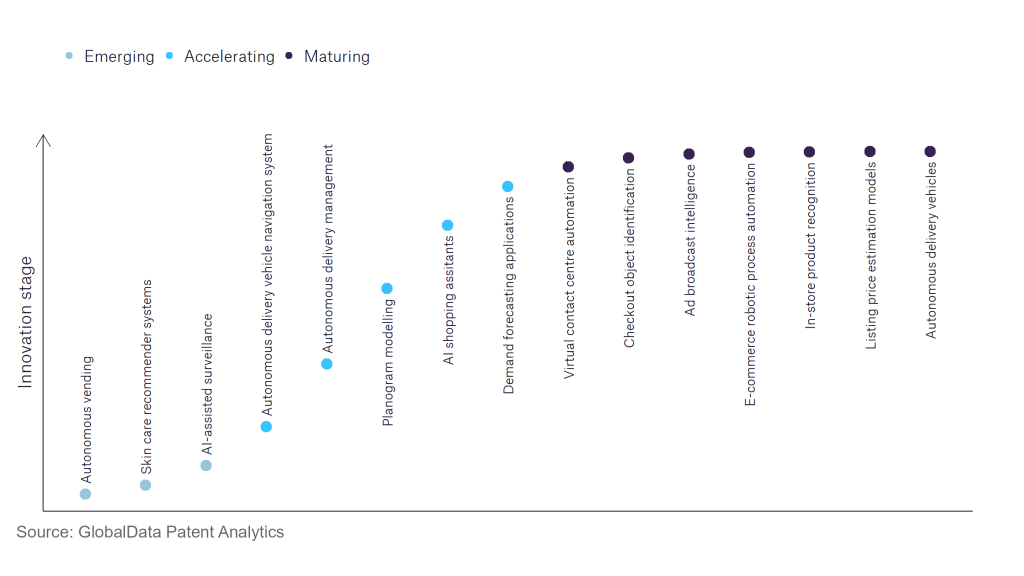The retail industry continues to be a hotbed of innovation, with activity driven by a number of factors including supply chain optimisation, risk mitigation, and the growing importance of technologies such as autonomous delivery management and robotic inventory management. In the last three years alone, there have been over 133,000 patents filed and granted in the retail industry, according to GlobalData’s report on Artificial Intelligence: Autonomous delivery management Buy the report here.
However, not all innovations are equal and nor do they follow a constant upward trend. Instead, their evolution takes the form of an S-shaped curve that reflects their typical lifecycle from early emergence to accelerating adoption, before finally stabilising and reaching maturity.
Identifying where a particular innovation is on this journey, especially those that are in the emerging and accelerating stages, is essential for understanding their current level of adoption and the likely future trajectory and impact they will have.
70+ innovations will shape the retail industry
According to GlobalData’s Technology Foresights, which plots the S-curve for the retail industry using innovation intensity models built on over 128,000 patents, there are 70+ innovation areas that will shape the future of the industry.
Within the emerging innovation stage, autonomous vending, skin care recommender systems, and AI-assisted surveillance are disruptive technologies that are in the early stages of application and should be tracked closely. Autonomous delivery vehicle navigation system, autonomous delivery management, and planogram modelling are some of the accelerating innovation areas, where adoption has been steadily increasing. Among maturing innovation areas are virtual contact centre automation and checkout object identification, which are now well established in the industry.
Innovation S-curve for artificial intelligence in the retail industry

Autonomous delivery management is a key innovation area in artificial intelligence
Autonomous delivery management involves the use of unmanned platforms to fulfil and manage product deliveries in a completely autonomous manner. These systems typically consist of autonomous drones or robots that get payloads and delivery instructions devoid of any human intervention.
GlobalData’s analysis also uncovers the companies at the forefront of each innovation area and assesses the potential reach and impact of their patenting activity across different applications and geographies. According to GlobalData, there are 10+ companies, spanning technology vendors, established retail companies, and up-and-coming start-ups engaged in the development and application of autonomous delivery management.
Key players in autonomous delivery management – a disruptive innovation in the retail industry
‘Application diversity’ measures the number of different applications identified for each relevant patent and broadly splits companies into either ‘niche’ or ‘diversified’ innovators.
‘Geographic reach’ refers to the number of different countries each relevant patent is registered in and reflects the breadth of geographic application intended, ranging from ‘global’ to ‘local’.
Patent volumes related to autonomous delivery management
| Company | Total patents (2021 - 2023) | Premium intelligence on the world's largest companies |
| Cox Enterprises | 121 | Unlock Company Profile |
| Walmart | 115 | Unlock Company Profile |
| Nuro | 113 | Unlock Company Profile |
| FedEx | 33 | Unlock Company Profile |
| Toyota Motor | 21 | Unlock Company Profile |
| Locus Robotics | 16 | Unlock Company Profile |
| Zume | 16 | Unlock Company Profile |
| Ocado Group | 15 | Unlock Company Profile |
| Indigo Agriculture | 14 | Unlock Company Profile |
| Qualcomm | 9 | Unlock Company Profile |
| Intel | 8 | Unlock Company Profile |
| Ford Motor | 7 | Unlock Company Profile |
| LG | 6 | Unlock Company Profile |
| Ninebot Beijing Tech | 6 | Unlock Company Profile |
Source: GlobalData Patent Analytics
Leading patent filers in the automated delivery management space include Cox Enterprises, Walmart, Nuro, and FedEx. American robotics company Nuro announced its third-generation autonomous vehicle for deliveries in January 2022. Compared to its previous iterations, this vehicle has a larger storage capacity. It also has a front airbag to protect pedestrians and bikers in the event of a collision. In September 2022, Uber Eats announced its plan to introduce Nuro’s autonomous delivery vehicles in Texas and California.
In terms of application diversity, Cox Enterprises, LG, Ninebot Beijing Tech, and Walmart are the leading companies.
In terms of geographic reach, Ocado Group, Ford Motor, Locus Robotics, and Ninebot Beijing Tech are the top players.
A major advantage of autonomous delivery vehicles is that their entire interior space and carrying capacity are dedicated to goods to be delivered. Apart from reducing the labour cost for deliveries, these vehicles also offer more freedom of design to bring optimum efficiency, as manufacturers don’t have to consider the comfort and safety of human delivery personnel. More retail companies are likely to adopt autonomous delivery management systems to drive operational efficiency.
To further understand the key themes and technologies disrupting the retail industry, access GlobalData’s latest thematic research report on Artificial Intelligence in Retail.
Data Insights
From

The gold standard of business intelligence.
Blending expert knowledge with cutting-edge technology, GlobalData’s unrivalled proprietary data will enable you to decode what’s happening in your market. You can make better informed decisions and gain a future-proof advantage over your competitors.



